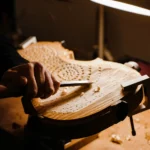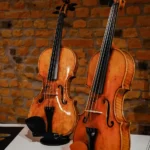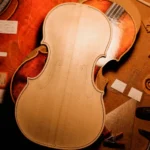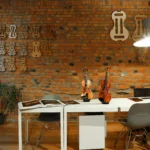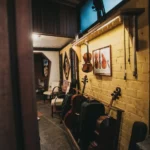Cello Bows: Cost, Prices, and Fine Selection for Sale
Back to BlogCello Bows: Cost, Prices, and Fine Selection for Sale
For any cellist, owning a fine bow is just as important as owning a good cello. A bow can bring out the best in your instrument, adding nuances to your performance; it will emphasize the overtones in the sound and can get out an extra 30 to 40% of your cello’s voice.
The bow itself does not make any sound, but it can accentuate different ranges of the cello’s potential sound spectrum as well as make the instrument produce more or less sound. A good bow will also allow you to play with more confidence, becoming an extension of your hand and making you play better.
Types of Cello Bows
Cello bows are shorter than violin and viola bows and need to be stronger as more pressure is required to play a cello. They are usually heavier and have a curved frog with a wider bow hair girth than a violin or viola bow. They come in two shapes: round and octagonal. Aesthetically, octagonal bows look nicer and, therefore, are preferred by musicians, although they are harder to make. Most cello bows are made of Pernambuco, Brazilwood, or Carbon Fiber.
- Pernambuco is a type of wood native to Brazil; it is the primary choice for professional players as its wood is dense and heavy and has the perfect mix of strength and responsiveness. It is now an endangered wood species and is more challenging to acquire.
- Brazilwood is a similar type of wood to Pernambuco and is also from Brazil; it is heavier than Pernambuco and, therefore, a little less responsive. It is a good alternative for students and beginners as it is cheaper and easier to find.
- Carbon fiber bows are usually factory-made and are a lot cheaper than wooden bows as they are made out of synthetic materials. However, they do not possess the playing qualities of wooden bows and should only be used as a starting point for playing the cello to be upgraded as soon as playing becomes more serious.
Factors Affecting Cello Bow Cost
The factors that influence the cost of a cello bow are the same as those that will affect the cost of the cello itself. The choice of materials, whether the bow is factory-made or handcrafted by an archetier, the skill and reputation of the archetier who made the bow, the age and general condition of the bow, and the history of the bow (was it used by a famous musician or in a vital orchestra, was it owned by a notable person, etc.) are just some of these factors.
Apart from the choice of wood, which will influence the cost, cello bows can also have horsehair or synthetic hair. Horsehair will be more expensive as it has a better feel and grip on the cello and will, in this way, accentuate the nuances of the instrument’s sound. The expertise of the archetier who crafts the bow will also influence the cost; specific techniques in making it will improve the overall quality. Of course, certain brands are also synonyms for excellence because they have an excellent reputation, which will also increase the cost of the bow.
Cello Bow Prices: What to Expect
The cheapest cello bows are typically factory-made, mainly created by machines with only a little bit of finishing by hand. Their price can range from anywhere between $50 and $150, and they are usually made out of carbon fiber.
Medium-quality bows are usually made by craftsmen in a workshop; they can be made out of either carbon fiber or Brazilwood, and their price ranges between $300 and $500.
For intermediate or professionals, cello bows range in price from $840 to $4000. These bows are handmade using Pernambuco wood and come from excellent contemporary bow makers.
The most expensive bows can range anywhere between $4000 and hundreds of thousands of dollars. These bows are made using the best materials and are made by renowned bow makers who have excellent skill and expertise or are historical bows made by famous archetiers of the past.
The ideal cello bow for you depends on what kind of player you are. Generally speaking, wooden bows are of higher quality, will help you play better, and add rich overtones to your sound. A factory-made carbon fiber bow is only suitable for people who are just starting and do not want to invest in their instrument and bow. However, it should be upgraded to a better quality bow as soon as possible as the sound produced will not be that good and can inhibit you from learning correctly.
For students and beginners, we would advise a cheaper handmade wooden bow. For professionals, depending on budget and preferences, any bow that is handcrafted by an expert and made with Pernambuco wood will definitely produce an excellent quality sound on your cello.
Fine Selection of Cello Bows
Here at Amorim Fine Violins Cremona, we offer a beautiful cello bow made by Louis Henri Gillet in 1955 for sale. This octagonal silver-mounted bow exhibits all the personal characteristics of Gillet’s work and shows the strength that makes his bow so sought after by great musicians. This bow portrays the moment of his highest experience and skills, the deeply personal, consistent approach, and the core inspiration by the work of Peccate, which is notable in the strong and precise chamfer and the head’s straight cheeks. The highlight of this bow is the fantastic quality of the red-brown pernambuco wood octagonal stick.
Louis Gillet is one of the most prominent heirs of Sartory’s legacy. His bows are recognized by their impactful sound and playability. Despite being influenced by different masters and references throughout his career, Gillet always preserved his very own personal approach.
This bow is a modern French masterpiece of excellence, and a master maker crafted it during the peak of his career. The strong character and high-level skill of Gillet’s work explain why his bows are appreciated by musicians, especially for their playability. In this particular piece, the amazing quality pernambuco wood and the precision of the octagonal-shaped stick are its high points.
You can own this exceptional masterpiece; click here to learn more details or try it out for free in your home if you are an EU resident with our Free Home Trial Program.
How to Choose the Right Cello Bow
When searching for the perfect bow, it is important to find one that will bring out the best sound from your cello. It must be properly sized, in good shape, and should feel comfortable in your hand while you are playing. We will outline some of the key things you should look out for when looking for the perfect cello bow. However, we recommend that you spend sufficient time trying out different bows until you are perfectly sure of your final choice.
Apart from the price, which is a matter of personal budget, there are four important factors that should be taken into consideration when choosing your new bow.
Balance of the bow
If the balance point is closer to the frog, the bow will feel lighter, but you probably will have to pronate your wrist with more intensity to produce extra volume or tone, as the tip will lack weight on itself to allow stronger contact between the bow hair and the string. On the other hand, if the balance point is too close to the tip, the bow will feel too heavy, difficult to control, and can make it slower, as you will have to keep adding energy to continue the sequences of faster movement techniques in all regions of the bow. A tip that is too light might jump off too much, and an excessively heavier one wouldn’t match the necessary elasticity to allow movement. Lighter, faster bows may match up with classic-period repertoire that will require most of the techniques of the French school, such as spiccato and sautillè and martelè. Heavier tip bows might be more suitable for late romantic or modern pieces, in which the musician is more constantly requested to connect for longer into the strings.
Strength of the bow
Stiffer bows have a faster response but may only produce a shallower sound, which will limit your ability to have a wider breadth of tone from your cello. If the stick is too soft, it won’t allow the musician to apply all the required arm weight in the bow to properly connect with the strings and secure that grip, as it won’t offer enough resistance. A more flexible bow can help create rich tones but may have a lower response time. With the bow tightened properly, the stick of the bow should not touch the strings when playing moderately loud.
Flexibility of the bow
A more flexible bow can help create rich tones but may have a quicker response time. With the bow tightened properly, the stick of the bow should not touch the strings when playing moderately loud.
Weight of the bow
Most cello bows weigh between 78-82 grams. A heavier bow should be perfectly balanced. Otherwise, it might feel too bulky and become tiresome to play. A lighter bow will feel easier to control but should have the perfect balance between strength and flexibility for it to perform well.
Cell Bow Maintenance and Care
A cello bow is just as important as the instrument itself. Without it, you wouldn’t be able to play your cello. Keep your bow in good condition, never tighten its hair too much, and loosen it after each use. Also, wipe the stick clean with a soft cloth to remove rosin dust after each time you play. If you regularly play your cello, remember to have it checked periodically by a luthier.
Here it is some tips for preserving the longevity and performance of the bow.
- When your bow is new or has new hair, apply rosin to the full length of the hair before you use it to play your cello.
- Never touch the bow hair with your fingers.
- Loosen the bow hair after each time you play and before you return it to its case. This will prolong the life of the hair and prevent the stick of the bow from warping.
- When playing your cello, a strand of the hair may occasionally fray and break. When this happens, clip off the strand near the frog and the tip, making sure not to clip off the other strands in the process.
- After a while, your bow’s hair will wear out. When this happens, take your bow to a luthier to have it checked.
A good cello bow should be like an extension of your hand. It should feel comfortable when you play and should bring out the best in your music. Consider this when searching for a new bow: it is better to invest more and have a better quality bow that helps you play beautifully, rather than holding back on expenses but then not being able to bring out your best potential and having to upgrade again soon.
Just like with your cello, sometimes your bow may be holding you back from improving your skills or may not match your current instrument. Many musicians do not realize they need a new bow until they see an improvement after trying out a new one. Take your time when searching for the perfect bow, and ask for help and consultation from teachers and professionals. Here at Amorim Fine Violins, we are always available for advice regarding your bow and instrument, do not hesitate to contact us.





